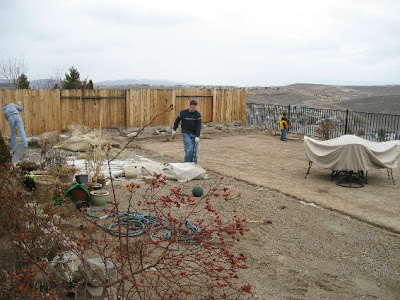Today’s post officially launches phase 2 of our grand gardening effort. The effort began when we turned this:

Into this:
And this:
Into this:

Now we will turn the above view into something resembling this:

The last photo, for you new readers, is of the tiny but terrific garden my husband and I built at our first house, between 2004 and 2009. (We loved it. But we couldn’t, unfortunately, have conversations in it because of the volume of traffic behind that wooden fence. )
So now we’re back to square one. Let’s review our mission as long as we’re here: to build a high-desert cottage-like garden that is crazy colorful without guzzling water. Color Palette? Purple, yellow, and pink. (With some chartreuse thrown in to help yellow and pink play nicely.)
And since every epic journey requires a map:
Which shrubs and flowers? I’m glad you asked. Time to introduce our cast of cottage-garden characters. Let’s start with the one I planted first: yarrow, or achillea.
This is ‘Apple Blossom’ yarrow, to be exact. Do you love her? I adore her. At least, so far I adore her. This is actually my first time planting yarrow, and it was only after planting that I discovered that the pink varieties-- known as achillea millefolium-- can be “vigorous to the point of weediness” according to my plant encyclopedia. Since “vigorous” is usually a euphemism for “invasive” I’ll have to let you know if this one turns into a thug as time goes on. For now, I’m in the honeymoon phase of the relationship, and I’m focusing entirely on her attributes.
Attribute number one: yarrow is drought-tolerant. So much so that, after planting, mine were looking sad and wilty until I backed off on water. They perked right up.
Two, this yarrow blooms a lovely deep pink but, as you can see in the photo above, each bloom changes to pale pink, and then to white, as it ages. The color variation between different blooms on the plant creates an effect similar to adding highlights to your hair: depth, dimension and interest.
Three, because of its nice flat shape (called “umbel” if you’re dying to know) yarrow is a magnet for beneficial insects including tachinid flies, lacewings, ladybugs, and the like.
I planted a row of three yarrow, and each of them should grow to be roughly 2 ½ feet tall and wide. Here they are after planting.
They look quite prim and polite, right? Let’s hope future photos don’t show them swinging nunchucks and threatening neighboring plants.

It could happen. Fingers crossed.
Here is the map with the yarrow on it in pink:
Next plant: Gaura lindheimeri .
If fairies had a favorite plant, this would be it. I purchased the above variety of gaura called ‘Whirling Butterflies,’ and you can see why. It looks like a cloud of white butterflies, especially when the wind blows. The photo above is from crocus.com. Here's another lovely one from Paghat's Garden.
Here's a photo I took of my baby plant where you can see the butterfly shape of the bloom:
Though I’ve heard this magical plant referred to as “wand flower,” around here, people use its Latin name, pronouncing it “GWAH-rah”.
I planted four behind our cast iron fountain near our wrought iron fence. I chose this plant not only because it’s drought tolerant, but because of my love for contrast in garden design. Since contrast generates intensity, what better plant to position behind a cast iron fountain than the delicate, whispy gaura? I also wanted a plant that wouldn’t completely block the view behind the fountain, which includes distant houses scattered over the hills. Here is the view of the fountain from our main patio with the view of distant houses in the background:
Now, work with me here, and remember that these are baby plants. Here are my four gaura after I planted them.
I know, I know, you can't see them even with the yellow circles around them. This is one of the troubles with photographing an infant garden, especially when the plants are delicate. Work with me here. Use your imagination and try joining the first photo of a mature gaura with the photo of the fountain.


Can you see it? Isn’t it outrageous? By this time next year we should have a photo to knock your garden hat off.
Here is our map with the fountain in black and the gaura in white:
Anyone else have any experiences with achillea millefolium or gaura lindheimeri they can share?
Stayed tuned for more planting!












